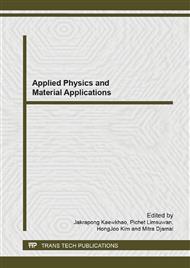p.30
p.34
p.38
p.42
p.46
p.50
p.54
p.59
p.64
Experimental Study of Double Glass Window with Phase Change Material
Abstract:
This paper presents a new technique for reducing solar gain in thermal insulated windows. The thermal characteristic of double glass window containing phase change material is investigated. A conventional double glass window is modified and filled with phase change material. Organic material, paraffin based, is selected due to harmlessness, chemical stability and its lack of phase separation. An indoor test facility is constructed where halogen lamps provide a simulated solar radiation. A consistent irradiance of 572 W/m2 and 663 W/m2 over the test area is measured by pyranometer. Double glass windows with and without phase change material are tested in the laboratory. The temperature distribution across the window is measured and the data are used for the analysis of heat transfer through window. Experimental results show that the phase change material acts as a thermal blockage. The temperature drop across the double glass pane with phase change material is higher than without using phase change material. The heat transmission through the proposed glazed window system at 90o solar incidence is 4.4% lower than the conventional window system.
Info:
Periodical:
Pages:
46-49
Citation:
Online since:
September 2013
Authors:
Keywords:
Price:
Сopyright:
© 2013 Trans Tech Publications Ltd. All Rights Reserved
Share:
Citation:


